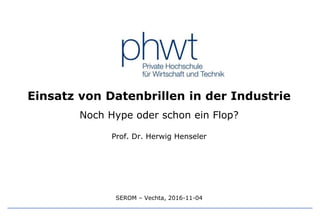
Einsatz von Datenbrillen in der Industrie
- 1. Einsatz von Datenbrillen in der Industrie 1 Einsatz von Datenbrillen in der Industrie Noch Hype oder schon ein Flop? Prof. Dr. Herwig Henseler SEROM – Vechta, 2016-11-04
- 2. Einsatz von Datenbrillen in der Industrie 2 Agenda n Google Glass n Projekt „Creating 4.0“ n Weitere HMD n Weitere Einsatzszenarien n In Zukunft
- 3. Einsatz von Datenbrillen in der Industrie 3 Google Glass Kamera CPU Batterie Prisma Lautsprecher Mikrofon Touchpad USB, Bluetooth, WLAN, UMTS, GPS, Kompass, Lagen-, Bewegungs- und Näherungssensoren
- 4. Einsatz von Datenbrillen in der Industrie 4 Google Glass Google Glass Preis 1500 € Gewicht 36g Transparenz 100% Display 640 x 360 Kamera 4,6 MP/720p OS Android 4.4 RAM 256 MB SSD 16 GB Taktrate 1,2 GHz Akku < 1h bei Vielnutzung
- 5. Einsatz von Datenbrillen in der Industrie 5 Projekt „Creating 4.0“ n Produktivitätssteigerung mit Mobile Devices n PHWT + Schulz Systemtechnik GmbH Visbek n 4 Dual Studierende der Elektrotechnik Christian Harms-Zumbrägel Tobias Hausfeld Janine Sprado Mario Wojack n Planung + Umsetzung eines Fallbeispiels Messevorführung
- 6. Einsatz von Datenbrillen in der Industrie 6 Projekt „Creating 4.0“ n Schema Handzugabeplatz
- 7. Einsatz von Datenbrillen in der Industrie 7 Projekt „Creating 4.0“ n Komponenten und Kommunikation
- 8. Einsatz von Datenbrillen in der Industrie 8 Projekt „Creating 4.0“
- 9. Einsatz von Datenbrillen in der Industrie 9 Projekt „Creating 4.0“
- 10. Einsatz von Datenbrillen in der Industrie 10 Projekt „Creating 4.0“
- 11. Einsatz von Datenbrillen in der Industrie 11 Projekt „Creating 4.0“
- 12. Einsatz von Datenbrillen in der Industrie 12 Projekt „Creating 4.0“
- 13. Einsatz von Datenbrillen in der Industrie 13 Projekt „Creating 4.0“
- 14. Einsatz von Datenbrillen in der Industrie 14 Projekt „Creating 4.0“
- 15. Einsatz von Datenbrillen in der Industrie 15 Projekt „Creating 4.0“ n Software 1.500 LOC Java für Glass 5.000 LOC C++/Qt für Controller n Fazit Google Glass ⇒ Google Glass Enterprise n Ausblick Portierung auf andere Datenbrille Sprachsteuerung + – Tragekomfort Akku Gewicht Hitze Durchsicht Displaygröße Preis QR-Code scan unzuverlässig/langsam
- 16. Einsatz von Datenbrillen in der Industrie 16 Weitere HMD (Head Mounted Displays) n Smart vs. Dumb n See-through vs. Non-see-through n Monokular vs. Binokular Vuzix M300 Epson Moverio Pro BT-2000 R7 Smart Glasses
- 17. Einsatz von Datenbrillen in der Industrie 17 Weitere HMD (Head Mounted Displays) Google Glass Moverio Pro BT-2000 R7 Smart Glasses Vuzix M300 Preis 1500 € 3100 € 2500 € 1400 € Gewicht 36g 290g+265g 142g 112g Transparenz 100% 50% 80% 100% Display 640 x 360 960 x 540 1280 x 720 640×360 Kamera 4,6 MP/720p 5 MP 720p 13 MP OS Android 4.4 Android 4.0 Android 4.4 Android 6 RAM 256 MB 1 GB 3 GB 2 GB SSD 16 GB 8 GB 64 GB 16 GB Taktrate 1,2 GHz 1,2 GHz 2,7 GHz 2,4 Ghz Akku < 1h 4h 1,5h 2h – 12h IP54? Akku tauschbar? Seite wechselbar?
- 18. Einsatz von Datenbrillen in der Industrie 18 Weitere Einsatzszenarien Handfreiheit Mobilität Sichtbarkeit Vernetzung
- 19. Einsatz von Datenbrillen in der Industrie 19 Beispiel: Instandhaltung
- 20. Einsatz von Datenbrillen in der Industrie 20 Beispiel: Telepräsenz
- 21. Einsatz von Datenbrillen in der Industrie 21 Beispiel: Logistik
- 22. Einsatz von Datenbrillen in der Industrie 22 Beispiel: Logistik n Picavi – Externer Akku
- 23. Einsatz von Datenbrillen in der Industrie 23 Weitere Einsatzszenarien n Montage / Wartung beengte Platzverhältnisse n Live-Video Drohne n Medizintechnik n Industrielle Rahmenbedingungen Bundesanstalt für Arbeitsschutz und Arbeitsmedizin (BAuA) l jährliche Expertenworkshops zu Datenbrillen: Aktueller Stand von Forschung und Umsetzung sowie zukünftiger Entwicklungsrichtungen Rechtliche Aspekte Gesundheitliche Aspekte Performanz
- 24. Einsatz von Datenbrillen in der Industrie 24 In Zukunft – Augmented Reality (AR)?
- 25. Einsatz von Datenbrillen in der Industrie 25 In Zukunft – Augmented Reality (AR)? n Augmented Reality (AR)
- 26. Einsatz von Datenbrillen in der Industrie 26 In Zukunft – Augmented Reality (AR)? n Microsoft Hololens
- 27. Einsatz von Datenbrillen in der Industrie 27 In Zukunft – Virtual Reality (VR)? n Microsoft Hololens
- 28. Einsatz von Datenbrillen in der Industrie 28 In Zukunft – Laserprojektion? n Fujitsu Prototyp: Kein Display, Laser auf Netzhaut
- 29. Einsatz von Datenbrillen in der Industrie 29 In Zukunft – Kontaktlinsen? n Samsung Patent: Display, Kamera und Sensoren
- 30. Einsatz von Datenbrillen in der Industrie 30 Diskussion Prof. Dr. Herwig Henseler henseler@phwt.de https://www.herwig-henseler.de/ Twitter: @herwighenseler
- 31. Einsatz von Datenbrillen in der Industrie 31 Copyright n Bildquellen Privataufnahmen von Studenten der Projektgruppe http://smartglassestechnology.com/wp-content/uploads/2016/02/vuzix-m300-smart- glasses-head-mounted-display.jpg https://www.epson.de/files/assets/converted/550m-310m/1/5/2/b/152b_03_09-.png.png http://www.osterhoutgroup.com/img/product/R-7-Perspective-1024x450.png http://picavi.com http://www.newyorker.com/wp-content/uploads/2016/07/Malik-Pokemon-1200.jpg https://www.microsoft.com/microsoft-hololens/de-de/hololens-commercial http://www.augmentedrealitytrends.com/wp-content/uploads/2013/11/TWNKLS- augmented-reality-for-Maritime-Industry.jpg https://www.gray.com/sites/default/files/gray_goggles_vr_image2_3x5_1.jpg http://scr.wfcdn.de/12608/Prototyp-der-Fujitsu-Datenbrille-1431423461-0-0.jpg https://www.mobilegeeks.de/news/samsung-tueftelt-an-smarten-kontaktlinsen-mit-display- und-kamera/ https://futurezone.at/science/forscher-ueberwinden-huerde-zum-kontaktlinsen- bildschirm/179.078.887
- 32. Einsatz von Datenbrillen in der Industrie 32 Abstract Im Projekt „Creating 4.0“ der Schulz Systemtechnik GmbH erarbeiteten vier Studierende einen Anwendungsfall für den Einsatz von Datenbrillen. Exemplarisch wurde die Unterstützung eines manuellen Mischvorgangs realisiert. Dafür wurde eine Software erstellt, die eine elektronische Waage, ein Prozessleitsystem sowie eine Google Glass miteinander vernetzt. Neben diesem Projektbericht wird allgemein beleuchtet, ob und wie Datenbrillen im industriellen Umfeld eingesetzt werden können.
